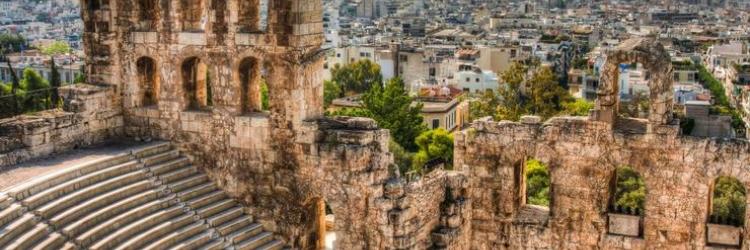Other Comments: 0 May 07, 2019
Athens is the capital of Greece and one of the most famous cities in Europe. Athens is one of the oldest cities in the world, whose history has been recorded for more than 3400 years.
Modern Athens is a great cosmopolitan city, while ancient Athens was a powerful city-state and a well-known educational and philosophical center. The city was named after the greek goddess Athena. Today, the metropolitan area of Athens has 3.7 million inhabitants, making it the second largest city on the list of the largest European hubs (behind London).
Athens is called the cradle of Western civilization due to cultural contributions during the 5th and 4th centuries BC. From that period in Athens, there were many antique buildings, works of art, etc. The most famous is the Acropolis, recognized as one of the best examples of Greek art and architecture.
Ancient Greece was the center of art, learning and philosophy, the home of Plato's Academy and Aristotle's Lice. Athens is also the birthplace of Socrates, Pericles, Sophocles and other important philosophers, writers and politicians.
The earliest known traces of people in Athens originate from the 11th to 7th millennium BC. The first organized life in Athens originates from the Neolithic, around 4000-3000. BC when the first inhabitants settled on the Acropolis and in the valley of the Ilis River (now Olympiad).
During the period 1550-1050, the economy advanced considerably, with architecture and art. About Mycenaean civilization there is a series of myths that are associated with the works of local princes. In the 12th century, most of the mycenaean centers were abandoned, wich was followed by migration of population on Greek soil. The tribes of Thessaly and Dorians were heading south, but in all likelihood, they never occupied Attica and demolished Athens, such as the destroyed Mycenae and Polos. However, Athens also entered the period of economic decline about 150 years later.
They also mixed with the tribes of the Jonas, who later, in the 8th century B.C as well as other Greek tribes, set out to the east creating colonies on the shores of Asia Minor. In the 8th century B.C. The different tribes of Attica have merged and turned Athens into its center, thus creating the first City State.
Ancient Athens was an ionic pole located on the peninsula of Attica. It was inhabited by aristocrats, demos (people) and slaves. In the earliest times, Athens was ruled by basileus (kings). Each year, nine aristocrats were called, called archons. They shared power with the isopag, a council sitting on a hill dedicated to the god of war Ares. However, demos people were not satisfied. There was a bitter struggle between them and the aristocrats. In the end, the right to take part of the authority were the rich craftsmen and demos salesmen. The National Assembly had the highest authority , which passed all decisions related to the governance of the state. Athens was a democratic and slave state.
Every Greek city or polis was a completely independent center of political, cultural, and commercial life, and Athens was one of the largest and strongest polices.
Each polis had a square, a gathering place - agora - which was primarily used for trade and various gatherings, and it was an administrative and social center. Athens, like most of the polis, was surrounded by walls, and it also had a place of last defense - the acropolis, where the temples of the supreme deities of Greece were located.
In the Greek-Persian wars, Athens, along with Sparta, led a coalition of Greek states that would eventually defeat the Persians, taking decisive victories at Marathon 490 B.C and Salamine 480. B.C. However, this did not prevent the Persians from capturing and destroying Athens twice, after the heroic resistance of the Spartans and their king Leonid near Termopil, after which both Beoti and Attica fell under the Persians.
The decades that followed were becoming known as the Golden Age democracy in Athens, in which Athens became the leading city of ancient Greece, with cultural achievements that became the basis of Western civilization. Writers Eshil, Sophocles, and Euripides were active at that time, as well as historians Herodotus and Tuccidus and the doctor Hippocrates. Led by Periklem, who fostered art and solidated democracy, Athens launched an ambitious construction program in which the Athenian Acropolis was built with Partenon, as well as in the project of building the Empire through the Delhi Alliance.
In the middle of the 4th century B.C the northern kingdom of Macedonia became dominant in politics. In the year 338 B.C. the army of Philip II of Macedonia defeated the alliance of Greek cities-states Athens and Thebes in the battle near Heron, which led to the end of Athens's independence. Later, under the rule of Rome, Athens gained the status of a free city for its respected schools. In the 2nd century, the Roman Emperor Hadrian built a library, a gymnasium, an aqueduct that is still used today, a bridge, several temples and shrines, and financed the completion of the Temple of the Olympic God Zeus.
Sights
Acropolis
The Athens Acropolis received It’s final form in the 5th century before the new era at the time of one the greatest and most important statesmen, Pericles. At the time of his reign, Athens became a democratic republic.
Pericles imposed high taxes on rich people , and the money was used to decorate Athens, especially the acropolis. During this period, he built magnificent temples, as well as magnificent works of art, so the period of Perikle's rule is called the golden age of Athens, the temples were built:
Parthenon
Erechtheion, the temple of goddess Nike
Propylaea - The solemn entrance
Parthenon is located on a plateau about 70 m high. and represents the backbone of the architectural settlement of the Acropolis. The parthenon can be seen from a great distance, but as you approach the Acropolis and begin climbing, it gradually disappears to be seen only when you come to it. When you climb to the plateau in front of it, you must go around in order to enter the temple itself, because the entrance is on the other side.
Parthenon is a longitudinal building in whose lobby is a relief showing the Panathenaic festivities. Relief (440 and 437 BC) is the work of Phidias and his disciples.
Erechtheion,
The temple, built around 421 B.C., due to the slope of the terrain, it is divided into several levels that are connected by a staircase. The height difference between the sanctuary of Athens and other parts of the temple is about 3 m. The temple, like most other temples, was not, in essence, the correct shape, and it contained the sanctuary of Athens, Poseidon, and the first Athenian king Erechthyus.
Propylaea
Propylaea - The solemn entrance, made up wide stairs between the two walls. At the very base of the staircase stood, connected on the upper side of the beams, six Doric pillars, and at the top the staircase was finished with a high wall where there was a entrence.
Athens is a popular destination for travelers. The Greek government, with the help of the EU, has done large infrastructure projects over the past decade, so the city infrastructure and social customs have been improved. The city is connected by a new network of roads, and from Serbia there are direct bus lines that go several times a week from Novi Sad, Belgrade and Niš, to Athens, Thessaloniki, Larisa and Katerini.


 RS
RS  ME
ME  HR
HR  BA
BA  RU
RU  MK
MK  AL
AL  ES
ES  DE
DE  IT
IT  CN
CN  NL
NL  SE
SE  FR
FR 






Write a comment